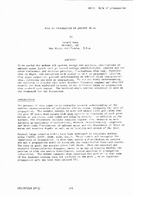| dc.contributor.author | Ross, Donald | |
| dc.date.accessioned | 2018-10-11T14:05:11Z | |
| dc.date.available | 2018-10-11T14:05:11Z | |
| dc.date.issued | 1982/06 | |
| dc.identifier | 607 | |
| dc.identifier.govdoc | CP-32/1 | |
| dc.identifier.uri | http://hdl.handle.net/20.500.12489/70 | |
| dc.description.abstract | To be useful for modern ASW systems design and analyses, descriptions of ambient noise fields must go beyond average omnidirectional spectra and include horizontal and vertical patterns, fluctuations with time, dependencies on depth, and variations with season as well as geographic location. This paper summarizes present understanding of ambient noise characteristics, stressing the role of propagation. To aid our basic understanding, the spectrum is divided into three distinct frequency regimes and observed results are then explained in terms of the different types of propagation that control each regime. The vertical-angle arrival structure is used as the framework for the discussion. | |
| dc.format | 18 p. : ill. ; digital, PDF file | |
| dc.language | English | |
| dc.publisher | NATO. SACLANTCEN | |
| dc.source | In: Underwater Ambient Noise (SACLANTCEN Conference Proceedings CP-32), Vol. 2, Part 1, 1982, pp. 1-1 - 1-18. | |
| dc.subject | Ambient noise | |
| dc.subject | Acoustic propagation | |
| dc.subject | Acoustic models | |
| dc.title | Role of propagation in ambient noise | |
| dc.type | Papers and Articles | |
| dc.type | Conference Proceedings (CP) | |
